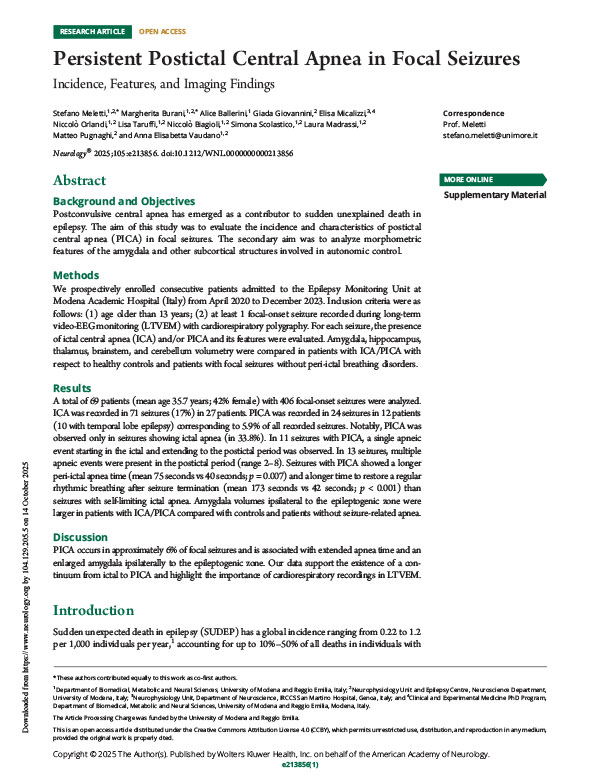Persistent Postictal Central Apnea in Focal Seizures
August 2025 | Neurology
Abstract
Background and Objectives
Postconvulsive central apnea has emerged as a contributor to sudden unexplained death in epilepsy. The aim of this study was to evaluate the incidence and characteristics of postictal central apnea (PICA) in focal seizures. The secondary aim was to analyze morphometric features of the amygdala and other subcortical structures involved in autonomic control.
Methods
We prospectively enrolled consecutive patients admitted to the Epilepsy Monitoring Unit at Modena Academic Hospital (Italy) from April 2020 to December 2023. Inclusion criteria were as follows: (1) age older than 13 years; (2) at least 1 focal-onset seizure recorded during long-term video-EEG monitoring (LTVEM) with cardiorespiratory polygraphy. For each seizure, the presence of ictal central apnea (ICA) and/or PICA and its features were evaluated. Amygdala, hippocampus, thalamus, brainstem, and cerebellum volumetry were compared in patients with ICA/PICA with respect to healthy controls and patients with focal seizures without peri-ictal breathing disorders.
Results
A total of 69 patients (mean age 35.7 years; 42% female) with 406 focal-onset seizures were analyzed. ICA was recorded in 71 seizures (17%) in 27 patients. PICA was recorded in 24 seizures in 12 patients (10 with temporal lobe epilepsy) corresponding to 5.9% of all recorded seizures. Notably, PICA was observed only in seizures showing ictal apnea (in 33.8%). In 11 seizures with PICA, a single apneic event starting in the ictal and extending to the postictal period was observed. In 13 seizures, multiple apneic events were present in the postictal period (range 2–8). Seizures with PICA showed a longer peri-ictal apnea time (mean 75 seconds vs 40 seconds; p = 0.007) and a longer time to restore a regular rhythmic breathing after seizure termination (mean 173 seconds vs 42 seconds; p < 0.001) than seizures with self-limiting ictal apnea. Amygdala volumes ipsilateral to the epileptogenic zone were larger in patients with ICA/PICA compared with controls and patients without seizure-related apnea.
Discussion
PICA occurs in approximately 6% of focal seizures and is associated with extended apnea time and an enlarged amygdala ipsilaterally to the epileptogenic zone. Our data support the existence of a continuum from ictal to PICA and highlight the importance of cardiorespiratory recordings in LTVEM.

